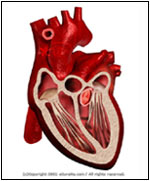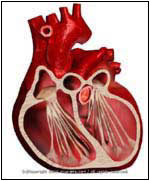|
|
 |

Normal |

Abnormal |
|
|
-
The heart has two sides: right and left. The right side of the heart pumps blood though the lungs. The left side of the heart then takes this freshly oxygenated blood, and pumps it to the other parts of the body, including the vital organs. When the left side of the heart is damaged or not working properly, it is unable to pump all the blood it receives. This will cause the fluid in the blood to back up into the lungs. It may also back up further and cause excess fluid in the liver, abdomen, and legs. This backup of fluid is called congestive Heart Failure. The name comes from the fact that Heart Failure causes
fluid to fill up (congest) the
lungs.
|
 |
- Shortness of breath
- Shortness of breath on exertion
- Shortness of breath when lying flat
- Leg swelling
(edema)
|
 |
- Lungs -- crackles, less often
wheezes
- Heart -- S3 gallop, murmur (especially Mitral Regurgitation)
- Neck -- distended veins
- Enlarged liver
- Enlarged fluid-filled abdomen
- Swollen legs (edema)
- Chest X-Ray shows
congestion, enlarged heart
- Electrocardiogram
may show irregularity or findings consistent with left
heart enlargement
- Echocardiogram
shows decreased or damaged heart function and/or valve
problems
- Cardiac catheterization may show
blocked heart vessels
- Swan-Ganz catheter assess of
pressures in heart and lungs
- Complete blood count to check for anemia
- Thyroid function tests
- Kidney and liver function tests
- Blood gas or oximetry will show
decreased
oxygenation
|
 |
- Oxygen
- Lasix IV
- Morphine Sulfate IV
- Nitroglycerin paste or IV
- Dobutamine IV
- Amrinone IV
- Nitroprusside
- ACE inhibitors IV
- Low Sodium diet
- Lasix
- Digoxin
- Nitroglycerin
- Hydralazine
- ACE inhibitors
- Carvedilol
- Blood thinners (Coumadin) if
severe heart damage (prevents blood clot
formation)
- Treat underlying cause, such as
thyroid problems
- Interventions:
- Angioplasty (balloon to open
vessels) or heart bypass grafts if there are coronary
artery blockages
- Heart transplant for patients in
whom all other treatments fail and they meet certain
criteria.
|
 |
-
In individuals who already have Heart Failure, not following a low Sodium diet or forgetting to take medications can precipitate an attack. It is especially important to know what foods contain high amounts of hidden Sodium. Foods such as tomato soup or pizza are so high in Sodium they can rapidly lead to an episode of Heart Failure.
|
| | |
If you want your friend to read or know about this article, Click here
 |
|
|

